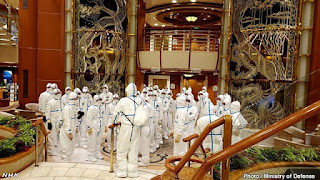News in pandemic times is not all gloom and doom. Some
actually make us laugh.
Take the headline: ‘Corona beer stops production’. This is one of the bestselling
Mexican beers across the world. In two recent surveys in America, 38% beer
drinkers said they would not buy this beer under any circumstances. 14% said
they won’t buy it in public. Corona had planned to launch a new hard Seltzer in
the USA last month. The promotion campaign said: ‘introducing Corona… four flavors.
Coming to your place soon.’ For some reason, Americans criticized it.
*****
Not having experienced a pandemic before, politicians
in different countries find original ways to impose restrictions. Congo locks down
people for 4 days, then they can move around freely for 2 days, then locked down
for four days again. Peru and Panama’s lockdowns are gender-based. Men can
leave the house on Mondays, Wednesdays, and Fridays. Women on Tuesdays,
Thursdays and Saturdays. Nobody can go out on Sundays.
*****
New York’s Health Department has issued guidelines on
how to enjoy sex in Covid-19 times. Since my Corona series has a wide
readership, I refrain from giving a précis. If you are above 18, and think
there is any practical utility, here is the NYC covid-sex-guidance. By way
of warning, I would mention three points. (a) These guidelines are for New
Yorkers, they may not apply to you. (b) The footnote says the NYC health
department may change their advice as the situation evolves. (c) The safest way
as prescribed by other sources is to keep a distance of at least six feet from
your partner during the act.
*****
In April, an Indian couple named their newly born son:
“Lockdown”. When the boy grows up, I can imagine mischievous reporters writing
about ‘Lockdown in school’ or ‘Lockdown at State Bank of India’.
Talking about naming the baby, Boris Johnson and his fiancée
Carrie Symonds had a baby boy this week. The mother and baby are doing very well;
the father is also not doing badly. The upper class Brits give three names to the baby. Johnson himself
is ‘Alexander Boris dePfeffel Johnson’.
Carrie wanted one of the names to be her grandfather’s.
And Boris wanted one to be his grandfather’s. Boris, in his usual nebulous way told her, ‘I
want to name him after the two doctors who saved my life.’ And he left for his
Zoom conference.
Two doctors? Which meant sacrificing one of the two
grandfathers. And since Boris is the Prime Minister, it would be Carrie’s
grandfather whose name would have to go. Carrie spent a few depressed hours
before Boris returned.
‘I wish we could have named him after my grandfather.’
She said. ‘We will.’ Said Boris.
‘But you want to name him after your grandfather as
well.’ ‘Yes, I do.’
‘And you want to name him after the two doctors who
saved your life.’ ‘Yes, I do.’
‘How is that possible?’ she said.
‘We are naming him Wilfred (Boris’s grandfather) Lawrie (Carrie’s grandfather) Nicholas
Johnson.’ Said Boris triumphantly. ‘Because the two doctors who treated me were
Dr Nicholas Price and Dr Nicholas Heart.’
*****
Ravi














